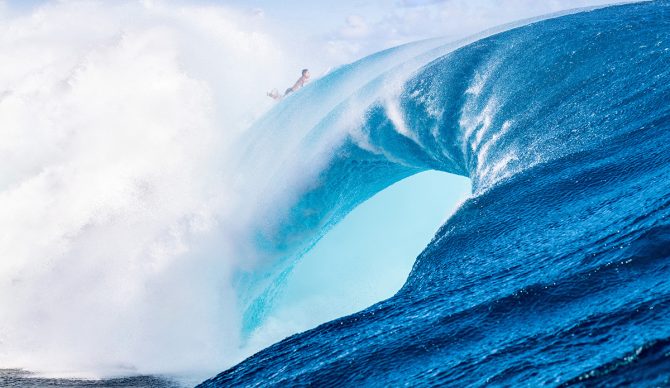 Just imagine putting an inexperienced young WSL or ISA Olympic hopeful into the kind of position that almost killed heavy water veteran Rodrigo Reinoso. photo: Ted Grambeau
Just imagine putting an inexperienced young WSL or ISA Olympic hopeful into the kind of position that almost killed heavy water veteran Rodrigo Reinoso. photo: Ted GrambeauRecent headlines concerning Kelly Slater’s Olympic aspirations has me thinking about the 2024 Paris Games, and the surfing event to be held at Teahupo’o, Tahiti, where, if by the sport’s expressed standard everything goes right, it could all go terribly wrong.
This dire prediction has nothing to do with imagining the complexities involved in holding an Olympic event 15,706 kilometers away from the main Olympic site in France. In fact, there’s precedent for this. In 1956, for example, due to Australian quarantine regulations, the Melbourne Olympic equestrian events were held in Stockholm, Sweden, 15,589 kilometers and a world away in the Northern Hemisphere, and that turned out all right (especially for the Swedes, who took home three of the possible six gold medals on offer that year.) So distance really isn’t the issue.
Nor are the logistics, really. Surf contests have been held at Teahupo’o for decades now, and both the event organizers and the residents of the tiny Tahitian village have the whole show wired; an Olympic event will be no different. Easier to run, actually, considering that there will be 10 less surfers in the men’s division to grind through the mill on the way to the top step on the winner’s stand (eight additional women, but I’ll get to that.) No worries about crowd control, either, seeing as how not only is there no place to park at the End Of The Road, but no place to watch the event except from Teahupo’o’s narrow reef pass, which can only hold so many camera boats, girlfriends on jet skis, plastic kayaks and smoothie barges before it starts looking like spring break at Lake Havasu, and becomes a danger to the surfers.
Sure, they’ll be none of the pomp and gravity of conventional Olympic competition; no Athlete’s Village, major network interview studios or stadium’s filled with cheering fans. For the majority of competitors, most of them culled directly from the WSL ranks, it’ll be just another contest at Teahupo’o. Which, of course, brings us to my point.
“This marks another milestone,” asserts 2024 Paris Games Organizing Chief Tony Estanguet in a recent press release championing the decision to hold the surfing event in Tahiti. “With our ambition being to deliver spectacular and sustaining Games that will offer a unique experience for the athletes.”
I’ll assume that the Olympic Organizing Committee members have seen plenty of footage of Teahupo’o, and have a grasp of what constitutes “spectacular,” not only in the opinion of longtime surfing fans but that of the many thousands of curious viewers responsible for HBO’s “100 Foot Wave” being renewed for a second season. If not, I’ll make it easy for them: spectacular means big. Really big. In Teahupo’o’s case, let’s say 20-foot minimum. Which means scary big. Forget the nightmare of it being flat (which can happen) or overhead and blown out (which has happened), even if it is eight-to ten-feet it will be a letdown to everyone, network broadcasters included, all of whom are hoping to see Olympic surfing gold being won in Tahitian Code Red.
And there’s the problem. Because if everything does go right, and sometime during the allotted one-week schedule a really big south swell and good winds arrive (good luck!), the Olympics could be faced with the truly unique spectacle of presenting Olympic athletes competing in an event in which they have absolutely no experience. Because make no mistake: very few of the world’s surfers are capable of surfing 20-to-30 foot Teahupo’o. And none became so by surfing in ISA qualifying heats.
It could be bad enough for the men’s division. Although almost half of the 24 competitors qualify on the WSL Championship tour (top two per country) plenty of those guys will be pushed to their limit if it gets big; some beyond that limit. The remainder of the field, having qualified through ISA World Surfing and Pan American Games, will be faced with an even greater challenge, having little experience competing in conditions even remotely like the fearsome Tahitian reef break.
But for the women surfers, a giant swell could be catastrophic. Even a precursory look at this year’s professional and amateur rankings will show that with the exception of Tahiti’s Vahine Fierro, not a single potential female Olympic qualifier has ever surfed a big day at Teahupo’o’. And I’m not talking about last year’s Outerknown event, where the women’s heats were run in four-to ten-foot surf. And I’m certainly not saying that none of the women qualifiers are capable of surfing a big day at Teahupo’o’. I’m just saying that up to now they haven’t, and that a single south swell season is hardly enough time to learn.
So can you imagine a Winter Olympic slalom ski racer, having qualified in that discipline, being told that, in fact, they’ll be competing in the downhill – or ski jumping on the large hill? That’s essentially the exact scenario that many of our Summer Olympic surfers will be facing if everything goes right at Teahupo’o. For the athletes, the consequence of failure could be grievous injury, but for the Olympic broadcast, it would be seeing a large percentage of the competitors electing, in all good conscience, to not even paddle out. And who, again in good conscience, could blame them, considering that instead of throwing the discus in Paris’ magnificent Olympic Stadium, swimming the 100 at the ultra-modern Seine St. Denis Aquatic Center or racing their road bikes along Paris’ beautiful Pont d’lena, these surfers will be going for gold at a place called Teahupo’o, whose name translated to English means “the severing of heads,” or, more colloquially, “place of skulls.”
What could go wrong?

